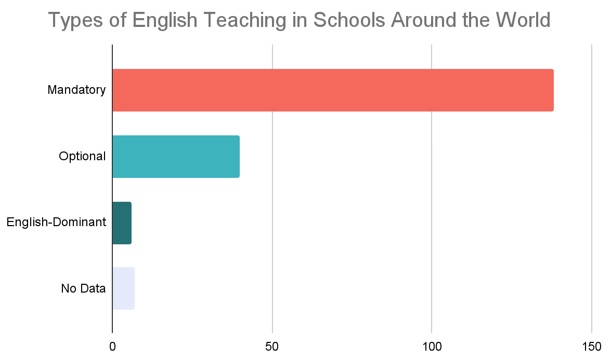India Toll Free : 1800 212 6400 | Phone : +919739615888
Email : act@asiancollegeofteachers.com | asiancollegeofteachers@gmail.com
A Guide To Enhancing Student Learning Through Aromas And Metaphors
14th June 2023
English is a language that is being taught in almost every part of the world. Every parent wants their children to learn English as it can open the door to plenty of opportunities in the future for their children. According to a preply.com survey, in almost every part of the world English teaching is mandatory.

Source: preply.com/en/blog/english-language-statistics
Because of this, there’s a huge demand for TEFL teachers who have pursued courses like 120-hour online TEFL course. However, learning a new language is like learning how to ride a cycle for the first time. It takes practice and patience to master it. TEFL teachers need to find some engaging and effective ways to teach English to make the student comfortable so they can easily comprehend as well.
One of the best ways to teach English to non-native English speaker students is by using Analogy and metaphor. Teachers who have done courses like TESOL Course India, know it very well the effectiveness of using Analogy and metaphors while teaching. However, there’s no need to worry, because our post will also help you to take advantage of using Metaphors and Analogies while teaching and their different types as well.
So, without any further ado, let’s get started.
Types of Metaphors and Analogies for Language Learning
There are many types of analogies and metaphors that TEFL teachers can use to help their students learn. Some of the most common types include:
1. Object Analogies
Object analogies involve comparing a new concept to a familiar object. For example- "Verb tenses are like different coloured balls. Each colour represents a different time frame."
2. Animal Analogies
Animal analogies involve comparing a new concept to a familiar animal. For example- "A phrasal verb is like a snake. It has a base verb, but it can also have a preposition or adverb that changes its meaning."
3. Sports Analogies
Sports analogies involve comparing a new concept to a familiar sport. For example-"Pronunciation is like golf. You need to practice the correct technique to improve your score."
4. Food Analogies
Food analogies involve comparing a new concept to familiar food. For example- "Adjectives are like spices. You can add them to your sentences to make them more flavourful."
5 Tips for TEFL Teachers to Use Metaphors and Analogies Effectively
Here are five tips for TEFL teachers to use analogies and metaphors effectively:
- Keep it simple: Use analogies and metaphors that are easy to understand and remember.
- Make it relevant: Use analogies and metaphors that are relevant to your student's cultural background and interests.
- Use visuals: Use pictures or drawings to help illustrate your analogies and metaphors.
- Be creative: Don't be afraid to think outside the box and come up with unusual analogies and metaphors.
- Practice: Practice using analogies and metaphors in your lessons until you find what works best for your students.
Examples of Analogies and Metaphors for Different Language Concepts
Here are some examples of how TEFL teachers can use analogies and metaphors for different language concepts:
1. Verb Tenses
Analogies: Verb tenses are like different coloured balls. Each colour represents a different time frame. Teaching past simple tense can be compared to watching a movie. The beginning is the introduction (setting the scene), the middle is the main plot (what happened), and the end is the conclusion (what was the outcome).
Metaphors: Verb tense is like a rollercoaster ride. Each turn represents a different verb tense.
2. Pronunciation
Analogies: Pronunciation is like golf. You need to practice the correct technique to improve your score. Pronouncing words correctly is like playing a musical instrument. You need to practice to get better.
Metaphors: Pronunciation is like a puzzle. You need to put the pieces (sounds) together to make the whole picture (word).
3. Vocabulary
Analogies: Vocabulary is like a garden. You need to plant the seeds (new words) and water them (review) to make them grow. Vocabulary is like a toolbox. You need to have the right tools (words) to complete a task (communicate).
Metaphors: Vocabulary is like a treasure hunt. Each new word you learn is like finding a new treasure.
Benefits Of Using Metaphors and Analogies
Using analogies and metaphors in TEFL has many benefits.
- It helps students understand complex concepts by breaking them down into simpler terms.
- Analogies and metaphors also make learning more enjoyable and engaging for students.
- It can help students retain information better, as they are more likely to remember something if it is linked to a familiar concept.
- Analogies and metaphors can be used to bridge the gap between the student's native language and English, making it easier for them to grasp new concepts.
Using Analogies and Metaphors in TEFL Teaching is Beneficial
Using analogies and metaphors in TEFL teaching can be a powerful tool for enhancing student’s learning known by every teacher who has pursued courses like TESOL Course India or 120-hour online TEFL course. They can help students understand new concepts, make learning more enjoyable, and improve retention. As a TEFL teacher, it is essential to be creative and find relevant analogies and metaphors that work for your students. By following the tips mentioned in this blog, you can effectively use analogies and metaphors in your lessons and help your students achieve their language learning goals.
Find the right course for you and try out the course. Whatsapp us at: +916292137532. You can also mail us at act@asiancollegeofteachers.com.

